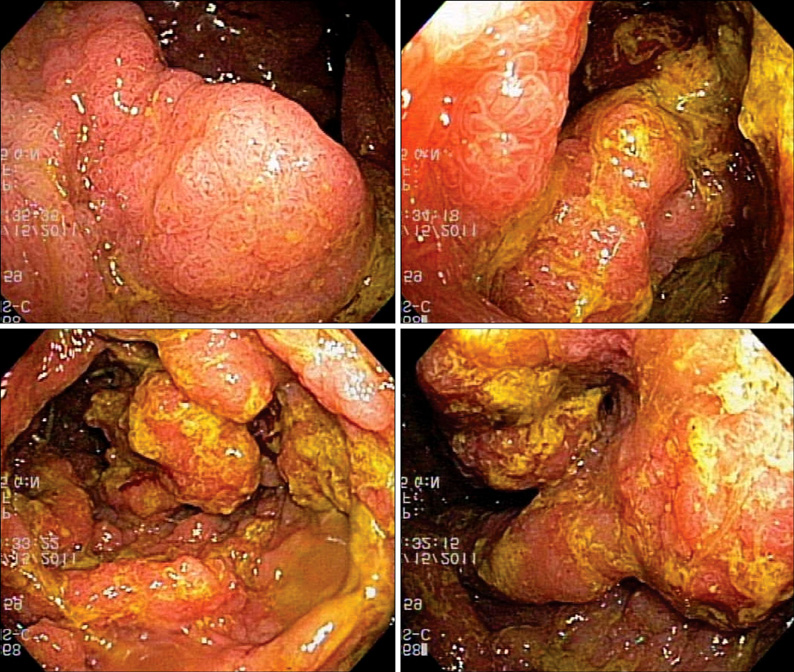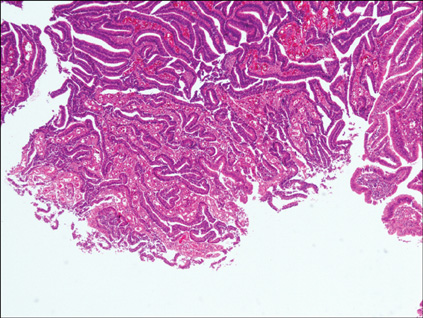J Korean Surg Soc.
2012 May;82(5):325-329.
A case of giant rectal villous tumor with severe fluid-electrolyte imbalance treated by laparoscopic low anterior resection
- Affiliations
-
- 1Colorectal Cancer Center, Kyungpook National University Medical Center, Kyungpook National University School of Medicine, Daegu, Korea. kyuschoi@mail.knu.ac.kr
Abstract
- McKittrick-Wheelock syndrome is a disorder caused by fluid and electrolyte hypersecretion from a colorectal tumor. To present the case of a patient with a giant rectal villous tumor with McKittrick-Wheelock syndrome who was successfully treated with laparoscopic surgery. The case of a 59-year-old man who came to the emergency department with syncope, prerenal azotemia, and electrolyte disturbances with a background of chronic diarrhea is reported. His condition was the result of fluid and electrolyte hypersecretion caused by rectal villotubular adenomas. Laparoscopic low anterior resection and subsequent volume and electrolyte replacement therapy resulted in complete recovery. A microscopic examination revealed multiple, well-differentiated adenocarcinomas arising in villotubular adenomas. Laparoscopic surgical resection is a feasible therapeutic modality for McKittrick-Wheelock syndrome.
Keyword
MeSH Terms
Figure
Reference
-
1. Older J, Older P, Colker J, Brown R. Secretory villous adenomas that cause depletion syndrome. Arch Intern Med. 1999. 159:879–880.2. McCabe RE, Kane KK, Zintel HA, Pierson RN. Adenocarcinoma of the colon associated with severe hypokalemia: report of a case. Ann Surg. 1970. 172:970–974.3. Targarona EM, Hernandez PM, Balague C, Martinez C, Hernández J, Pulido D, et al. McKittrick-Wheelock syndrome treated by laparoscopy: report of 3 cases. Surg Laparosc Endosc Percutan Tech. 2008. 18:536–538.4. Watari J, Sakurai J, Morita T, Yamasaki T, Okugawa T, Toyoshima F, et al. A case of Cronkhite-Canada syndrome complicated by McKittrick-Wheelock syndrome associated with advanced villous adenocarcinoma. Gastrointest Endosc. 2011. 73:624–626.5. Miles LF, Wakeman CJ, Farmer KC. Giant villous adenoma presenting as McKittrick-Wheelock syndrome and pseudo-obstruction. Med J Aust. 2010. 192:225–227.6. Lee YS, Lin HJ, Chen KT. McKittrick-Wheelock syndrome: a rare cause of life-threatening electrolyte disturbances and volume depletion. J Emerg Med. 2010. 01. 21. [Epub]. http://dx.doi.org/10.1016/j.jemermed.2009.11.026.7. Popescu A, Orban-Schiopu AM, Becheanu G, Diculescu M. McKittrick-Wheelock syndrome: a rare cause of acute renal failure. Rom J Gastroenterol. 2005. 14:63–66.8. Pokala N, Delaney CP, Kiran RP, Brady K, Senagore AJ. Outcome of laparoscopic colectomy for polyps not suitable for endoscopic resection. Surg Endosc. 2007. 21:400–403.9. Nusko G, Mansmann U, Altendorf-Hofmann A, Groitl H, Wittekind C, Hahn EG. Risk of invasive carcinoma in colorectal adenomas assessed by size and site. Int J Colorectal Dis. 1997. 12:267–271.10. Hauenschild L, Bader FG, Laubert T, Czymek R, Hildebrand P, Roblick UJ, et al. Laparoscopic colorectal resection for benign polyps not suitable for endoscopic polypectomy. Int J Colorectal Dis. 2009. 24:755–759.
- Full Text Links
- Actions
-
Cited
- CITED
-
- Close
- Share
- Similar articles
-
- Laparoscopic Low Anterior Resection in a Rectal Cancer Patient with Situs Inversus Totalis: A Case Report
- A Case of Villous Adenoma with Depletion Syndrome
- Feasibility of Single-Incision Plus One Port Laparoscopic Low Anterior Resection for Rectal Cancer
- Colorectal Perforation After Anorectal Manometry for Low Anterior Resection Syndrome
- A Case of Rectal Implantation Cysts at an Anastomosis Site after Laparoscopic Low Anterior Resection for a Rectal Cancer





